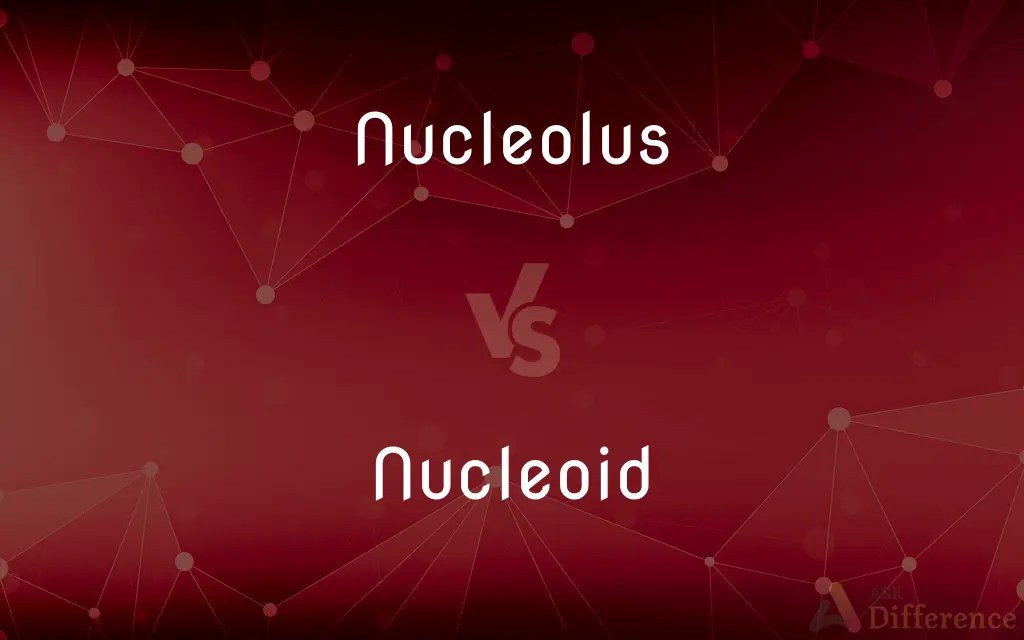Nucleolus vs. Nucleoid — What's the Difference?
By Maham Liaqat & Fiza Rafique — Updated on March 30, 2024
The nucleolus is a dense region within the nucleus of eukaryotic cells, whereas the nucleoid is an irregularly shaped region in prokaryotic cells containing DNA.

Difference Between Nucleolus and Nucleoid
Table of Contents
ADVERTISEMENT
Key Differences
The nucleolus and nucleoid are critical cellular structures that play distinct roles in the organization and function of cells, reflecting the fundamental differences between eukaryotic and prokaryotic cells. The nucleolus, located within the nucleus of eukaryotic cells, is primarily involved in the synthesis and assembly of ribosomes, the cellular machinery responsible for protein production. On the other hand, the nucleoid is an area in prokaryotic cells, such as bacteria, that contains the cell's genetic material. Unlike the nucleolus, the nucleoid is not enclosed by a membrane, and its DNA is not associated with histones or organized into chromosomes but exists in a loosely coiled state that can fill a significant portion of the cell.
While the nucleolus is a specialized entity for rRNA production and ribosome assembly, the nucleoid functions as the command center of prokaryotic cells, containing most of the genetic information required for cell function, replication, and gene expression. The organization of genetic material within the nucleolus and nucleoid reflects the complexity and differences in gene expression regulation between eukaryotes and prokaryotes. Eukaryotic cells compartmentalize their genetic material within the nucleus, with the nucleolus serving a specific function in ribosome synthesis. In contrast, the nucleoid region of prokaryotes encompasses the entire genetic content in a more accessible, yet organized manner, allowing for efficient control over cellular functions in the absence of a nucleus.
The presence of a nucleolus and the absence of a nucleoid in eukaryotic cells, versus the presence of a nucleoid in prokaryotic cells, underscores the structural and organizational differences between these two cell types. The nucleolus is a byproduct of the eukaryotic cell's compartmentalization, which includes a defined nucleus enclosing the cell's genetic material. This compartmentalization allows for intricate regulation of gene expression and cellular function. Conversely, prokaryotic cells, characterized by their lack of a nucleus and simpler organizational structure, rely on the nucleoid to house their genetic information, reflecting an efficient and streamlined approach to genetic material organization and access.
The impact of these structures on cellular function is profound. The nucleolus plays a crucial role in protein synthesis by ensuring a steady supply of ribosomes, essential for translating genetic information into proteins. This is vital for cell growth, division, and responding to environmental changes. The nucleoid, however, directly influences the prokaryotic cell's ability to reproduce, respond to environmental stimuli, and carry out metabolic functions through its genetic content. It allows for rapid adaptation and evolution by facilitating quick changes in gene expression in response to external conditions.
Understanding the differences between the nucleolus and nucleoid provides insights into the evolutionary adaptations of cellular life forms. The nucleolus represents an advanced feature of eukaryotic cells, enhancing their ability to control and specialize in various biological processes through compartmentalization and specialized structures. The nucleoid, with its simpler organization, showcases the efficiency and adaptability of prokaryotic cells, enabling them to thrive in diverse environments with minimal cellular machinery. This contrast reflects the diversity of life at the cellular level and the varying strategies cells employ to fulfill their biological roles.
ADVERTISEMENT
Comparison Chart
Location
Within the nucleus of eukaryotic cells
In prokaryotic cells, not membrane-bound
Composition
RRNA, proteins, and DNA segments
DNA, some RNA, and proteins
Function
Ribosome synthesis and assembly
Contains the genetic material for cell function and reproduction
Structural Features
Dense, distinct structure within the nucleus
Irregularly shaped region without a membrane
Presence in Cell Types
Eukaryotic cells only
Prokaryotic cells only
Compare with Definitions
Nucleolus
A structure within the nucleus of eukaryotic cells dedicated to producing ribosomal RNA (rRNA).
The nucleolus is visibly darker under a microscope due to its dense composition of rRNA and proteins.
Nucleoid
Essential for controlling the cell's activities and responding to environmental changes.
The nucleoid enables rapid bacterial adaptation by facilitating quick genetic transcription.
Nucleolus
The site of ribosome subunit assembly in the cell nucleus.
Ribosomal proteins from the cytoplasm enter the nucleolus to assemble with rRNA.
Nucleoid
Not enclosed by a membrane, allowing direct access to DNA for replication and transcription.
Enzymes for DNA replication and transcription interact directly with the nucleoid.
Nucleolus
Composed of DNA, RNA, and proteins, it plays a critical role in cell function.
Disruption in nucleolus function can lead to diseases due to impaired protein synthesis.
Nucleoid
The region in prokaryotic cells where the circular DNA molecule is located.
The nucleoid contains the genetic blueprint for the bacterium's structure and function.
Nucleolus
Acts as a stress sensor, adjusting its activities in response to cellular conditions.
Under stress, the nucleolus may alter its size and function, reflecting changes in the cell's metabolic state.
Nucleoid
Plays a crucial role in cell division by ensuring genetic material is accurately replicated.
Before a bacterium divides, the nucleoid replicates, ensuring both daughter cells inherit genetic material.
Nucleolus
It reforms after cell division, indicating its importance in cellular activities.
The nucleolus reappears in the nucleus after mitosis, ready to resume its role in ribosome production.
Nucleoid
The DNA within the nucleoid is compacted into a manageable structure without histones.
Prokaryotic DNA is organized through supercoiling and binding proteins instead of histones.
Nucleolus
The nucleolus (, plural: nucleoli ) is the largest structure in the nucleus of eukaryotic cells. It is best known as the site of ribosome biogenesis.
Nucleoid
The nucleoid (meaning nucleus-like) is an irregularly shaped region within the prokaryotic cell that contains all or most of the genetic material. The chromosome of a prokaryote is circular, and its length is very large compared to the cell dimensions needing it to be compacted in order to fit.
Nucleolus
A small body in the nucleus of a cell that contains protein and RNA and is the site for the synthesis of ribosomal RNA and for the formation of ribosomal subunits.
Nucleoid
The undefined region of genetic material inside a prokaryotic cell, consisting of aggregated DNA.
Nucleolus
(cytology) A conspicuous, rounded body within the nucleus of a cell.
Nucleoid
(microbiology) The irregularly-shaped region within a prokaryote cell where the genetic material is localized
Nucleolus
A little nucleus.
Nucleolus
A small rounded body contained in the nucleus of a cell or a protozoan.
Nucleolus
A small round body of protein in a cell nucleus; nucleoli contain RNA and are involved in protein synthesis
Common Curiosities
What role does the nucleoid play in prokaryotic cells?
It contains the genetic material necessary for the cell's function, replication, and response to environmental changes.
How does the nucleolus function?
It functions in producing ribosomal RNA and assembling ribosome subunits, crucial for protein synthesis.
What is the nucleolus?
The nucleolus is a dense region within the nucleus of eukaryotic cells, primarily involved in ribosome synthesis.
What types of RNA are produced in the nucleolus?
The nucleolus mainly produces ribosomal RNA (rRNA).
Are nucleoli present in prokaryotic cells?
No, nucleoli are exclusive to eukaryotic cells; prokaryotic cells contain nucleoids instead.
How is the nucleoid different from a nucleus?
The nucleoid is an unenclosed region containing DNA in prokaryotic cells, whereas a nucleus is a membrane-bound organelle in eukaryotic cells.
Can eukaryotic cells have nucleoids?
No, eukaryotic cells have nuclei with nucleoli, not nucleoids.
What is the significance of the nucleolus in cellular stress?
The nucleolus can adjust its size and function in response to stress, affecting ribosome production and cell health.
What is the nucleoid?
The nucleoid is an irregularly shaped region in prokaryotic cells that contains the cell's DNA.
Can the nucleoid be seen under a light microscope?
It is difficult to see the nucleoid under a standard light microscope without special staining techniques.
How does the structure of the nucleoid affect its function?
Its open structure allows for efficient gene expression and replication necessary for the cell's rapid response to its environment.
Is the DNA in the nucleoid organized into chromosomes?
No, prokaryotic DNA in the nucleoid is typically a single circular chromosome, not organized into discrete chromosomes.
How are ribosomes related to the nucleolus?
Ribosomes, essential for protein synthesis, are partially assembled within the nucleolus from rRNA and proteins.
How do prokaryotic cells compensate for the lack of a nucleus?
They use the nucleoid region for efficient, direct access to genetic information, facilitating quick adaptation and function.
What happens to the nucleolus during cell division?
It disassembles and then reassembles in each daughter cell's nucleus, ensuring continuous ribosome production.
Share Your Discovery

Previous Comparison
Ideology vs. Theory
Next Comparison
Consumable vs. DisposableAuthor Spotlight
Written by
Maham LiaqatCo-written by
Fiza RafiqueFiza Rafique is a skilled content writer at AskDifference.com, where she meticulously refines and enhances written pieces. Drawing from her vast editorial expertise, Fiza ensures clarity, accuracy, and precision in every article. Passionate about language, she continually seeks to elevate the quality of content for readers worldwide.














































